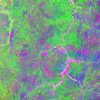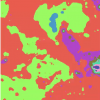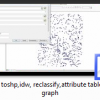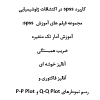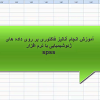ASTER (Advanced Spaceborne Thermal Emission and Reflection Radiometer) is an advanced multispectral sensor that is a facility instrument selected by NASA to fly on the Terra polar orbiting spacecraft in December 1999, and covers a wide spectral region from visible to thermal infrared with 14 spectral bands with high spatial, spectral and radiometric resolution. The spectral bandpasses are shown in Table 2-1. The wide spectral region is covered by three telescopes, three VNIR (Visible and Near Infrared Radiometer) bands with a spatial resolution of 15 m, six SWIR (Short Wave Infrared Radiometer) bands with a spatial resolution of 30 m and five TIR (Thermal Infrared Radiometer) bands with a spatial resolution of 90 m. In addition one more telescope is used to see backward in the near infrared spectral band (band 3B) for stereoscopic capability that will produce a base-to-height ratio of 0.6. Please refer to Volume I for more details on the ASTER instrument and the science objective.
This multi-telescope configuration necessitates inter-telescope band-to-band registration with an image matching technique in the Level-1 algorithm. The intra-telescope band-to-band registration for the SWIR bands is also carried out with the image matching technique to remove the parallax error due to the detector distribution on the focal plane. The ASTER instrument has two types of Level-1 data, Level-1A and Level-1B data. Level-1A data
are formally defined as reconstructed, unprocessed instrument data at full resolution. According to this definition the ASTER Level-1A data consist of the image data, the radiometric coefficients, the geometric coefficients and other auxiliary data without applying the coefficients to the image data to maintain the original data values. The Level-1B data are generated by applying these coefficients for radiometric calibration and geometric resampling. All acquired image data are required to be produced to Level-1A. The ASTER Ground Data System (ASTER GDS) must handle a large amount of data, because the ASTER instrument has a high spatial resolution. The average data rate allocated to the ASTER instrument is limited to 8.3 Mbps which roughly corresponds to a duty cycle of 8 %. S Therefore, the maximum daily data volume which the ASTER GDS must handle is 780 sets of 60 km x 60 km scenes and corresponds to about 80 GB daily. A maximum of 310 scenes per day are to be processed to Level-1B data in response to requests from users
…..

